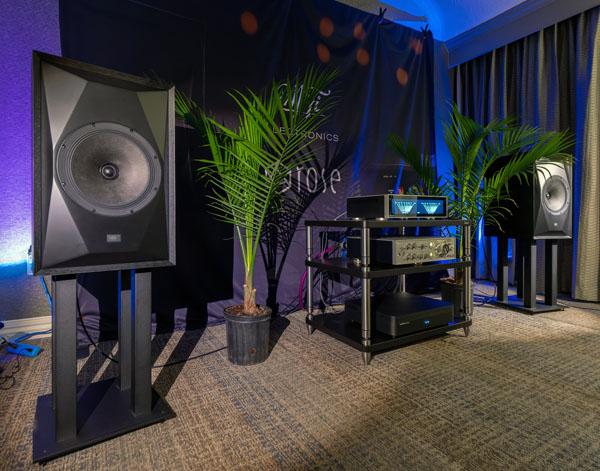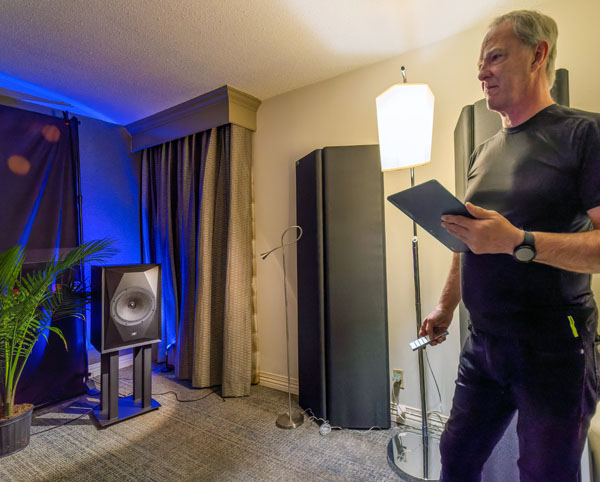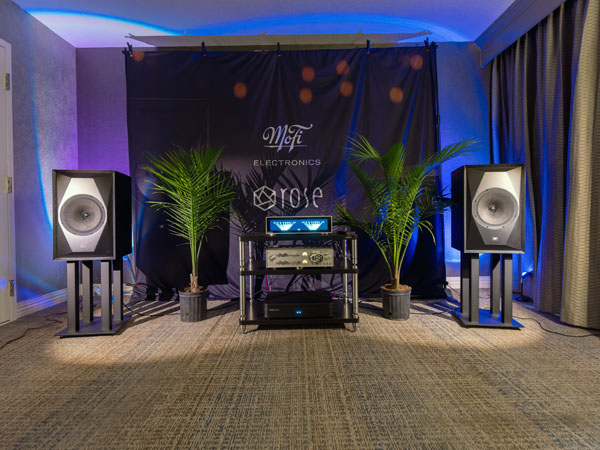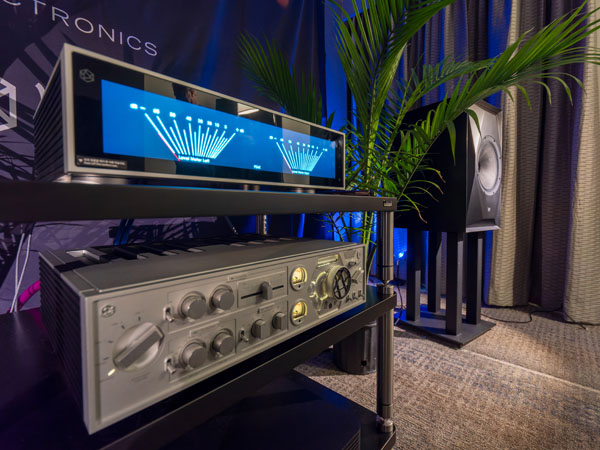Interview with Andrew Jones: MoFi SourcePoint 10 Loudspeakers

S&V: This seems like the culmination of a long journey to making a relatively affordable high-performance, high-end speaker. Andrew Jones: It's interesting. In the last 10 years, I guess I've been doing these very affordable speakers. You're starting with that Pioneer at $100 and all the way through ELAC, but it's not that that's the only type of speaker I've done, obviously I've done the high end with TAD I also did all the middle ranges as well at one time. And so I thought in joining MoFi, why would we keep on doing those low end ones because they're all still out in the marketplace, still available, why compete directly with myself right? What else do we want to do? And MoFi isn't a speaker company, they're a company doing speakers. So the dynamics of what you want to be producing, you don't need whole ranges or you'd have five speaker models, like I ended up doing with ELAC. So, let's target “what do we want to do?” And once we got that, it's “well what kind of price point?” And it's not gonna be those low price points. So, give me some freedom to do something new and interesting. And that's the great thing. It's been nearly two years now. And I had to find facilities, I told them “You know, I'm not moving to Chicago.” So, I had to find some facilities close to home, had to start setting up the lab— the listening room and the measuring room—as well as starting to come up with ideas for what the speaker might be.
Andrew Jones: It's interesting. In the last 10 years, I guess I've been doing these very affordable speakers. You're starting with that Pioneer at $100 and all the way through ELAC, but it's not that that's the only type of speaker I've done, obviously I've done the high end with TAD I also did all the middle ranges as well at one time. And so I thought in joining MoFi, why would we keep on doing those low end ones because they're all still out in the marketplace, still available, why compete directly with myself right? What else do we want to do? And MoFi isn't a speaker company, they're a company doing speakers. So the dynamics of what you want to be producing, you don't need whole ranges or you'd have five speaker models, like I ended up doing with ELAC. So, let's target “what do we want to do?” And once we got that, it's “well what kind of price point?” And it's not gonna be those low price points. So, give me some freedom to do something new and interesting. And that's the great thing. It's been nearly two years now. And I had to find facilities, I told them “You know, I'm not moving to Chicago.” So, I had to find some facilities close to home, had to start setting up the lab— the listening room and the measuring room—as well as starting to come up with ideas for what the speaker might be.
S&V: So, you home-brewed the totality of the development process.
Andrew Jones: Yes. And then found manufacturing partners. Initially, we pondered about building in the USA, but to set up everything that I'm doing and to set up the facilities to do it—although we have manufacturing in the US for MoFi, they don't make speakers. And so now having to set up all of that, it would mean years before we were able to be in a position to do something. So we said "we can do that later." But let's go back to the vendors I've been using in China because I've got some very good vendors that can do very consistent work. And let's start thinking well, what do we want to do? And obviously it'd follow what I'm known for doing: Concentric drivers whenever I can.
S&V: Because there's some logic behind that...
Andrew Jones: Right. Yeah, why abandon it, that would be like going back to KEF and going "you're not going to do concentric drivers any longer..." "What?" "I was wrong... (laughs)." But I'm not trying to deliberately be different, but looking at the concept of the kind of speaker we wanted to do, how did that drive my choices? And we started thinking, Well, what's popular at the moment is midcentury modern throwbacks to the old JBL and KHLs and Cerwin Vegas, and things like that.
So big woofers. And, you know, there's always this, maybe myth, that big woofers always sound better than small woofers. And you know, I would say, yeah, but bass is about how much air you move it's area times excursion. It can produce the same bass levels with long excursion smaller drivers, rather than big diameter small excursion drivers. But people say they definitely sound different. Well, maybe we should find out because if this throwback is to big woofers. Why don't we do a big woofer? Because MoFi said "We'd like… you know… good, impactful bass." Okay, so let's develop a 10-inch, and then it's, well, do we make it three-way like I have with all the other concentric drivers? Because I want to minimize cone excursion.
If I've got a 10-inch it doesn't have to move nearly as far to produce the bass, so I don't have all that modulation distortion. So, okay, let's try and not only experiment with a 10-inch bass/mid unit, but one that is a concentric. Once we've got that, as "yeah, that will be cool it's old and new Andrew” kind of thing. How do I do it? How do I make it? What design choices do I make in cone materials and cone shapes and motor assembly? So that's what's occupied a lot of the time, developing all that, because it's me. It's not as if I have a team. And, you know, obviously I partner with factories that know how to build things. But it's still, I have to tell them what to build. They're not saying oh, why don't we do this? Only if it makes sense from—if I've drawn up a magnet system, and they look at it and go, "But it would be more straightforward to construct if we change this detail here and forge it in this way…" and that's fine. I want that kind of input. But I don't want them changing the concept of what I'm trying to achieve.
So, we've been busy doing all of that and then this is the culmination and it's fun to be out here because people are going and this sounds big-headed, but "what is Andrew going to do next?" Um, well this is it, it is a bit of me and a bit of something you didn't expect, especially doing the two-ways—since I've always said I would never do a two-way concentric and now I have, but you know, I'm happy... I mean, I'm really happy with what I'm getting.

I've set up this listening room, and it's a really nice-looking space and a really nice sounding space. And since it's only me there, every morning I come in and start listening before I get into the real work and listening to these speakers kind of renewed me, because I'm just enjoying it so much. So this has been a fantastic two years working with MoFi and I'm the happiest I've been in a long time.
S&V: Because you got that kind of freedom?
Andrew Jones: I got the freedom—they'd asked me and they budgeted for an assistant. I mean... hell no, I'm going to enjoy being by myself. This speaker is 46 pounds and that's the limit of what I want at my age to be lifting around. But what I did need help and we eventually did, I hired someone in China that I've known for 20-odd years that—there's always been a representative between Chinese factories and American businesses and I've worked with her when I first started at Pioneer and I kept in touch with her, she did a lot work with Klipsch, she knows all the factories, she knows about shipping, she knows about talking to the engineers even though she's not an engineer herself.
S&V: You are minimizing trips to China.
Andrew Jones: The problem is, I can't go to China because of the quarantine restrictions. I mean, they brought it down to about a week. But it's a week locked up in one hotel that they take you to from the airport and they lock the door and three times a day knock on the door. You open the door, there's the food, and then it's locked behind you. I don't want to, I can't do that. She's my eyes and ears, so two or three times a week, I come home to have dinner and then get on the phone to discuss stuff and it's worked out superbly well.
But you know in a way COVID was good. It seems odd to say this, but I wasn't doing any shows, none of those requirements to keep moving about. I could focus fully on getting this developed and take the time to develop it. Not "oh, we need it in six months." It was "we'd like it in maybe a year from starting," but that didn't happen. Because once we started these concepts we knew it was going to take longer to develop. But why launch something with a new company when it's just no different? Instead we can do something different, to take the time and determine what its price point is going to be based on that and don't keep saying well, you know if we could hit that $300 cheaper, it would be a natural price point, but that means now you into cheapening the product and not making such a statement. So we resisted that. And we said no, that's just it falls where it falls. And as long as it still represents good value for that price, then we've met all the objectives.
S&V: And in context of what you see at a show like this, a tremendous value. And I've heard that theme, some engineers and designers and such actually appreciated that extended period of creativity, especially the more hermit-like. So, with a big woofer like that, it does seem that you can sit pretty close and they’re cohesive right away.
Andrew Jones: That's because it's concentric, right? That helps enormously. But the other interesting thing about it is what cone materials and what tweeter materials do you use? Do I go for doing exotic materials? But when I started looking at—I've never done a bass/midrange at that size, I've done 10 inch bass drivers like for the TAD—but it's a whole different requirement when it's got to be a 10-inch bass/midrange in a two-way system. So although it's the lowish crossover point, it's at 1.6 kilohertz, so I had to make sure the tweeter can go down that low. Once you have got a tweeter in a 10-inch waveguide, there's a lot of help at the low frequencies. So that worked for me, but it's "Okay, where are the cone resonances going to be? How high can I push them in a 10-inch driver?" And so often—I know it's sort of a wrong comparison—but if you look at a lot of the exotic material 10-inch bass drivers, the cone breakup is about 1 kHz. And that's obviously not good enough. It's fine for a bass driver, but not for a midrange. Also a lot of these advanced materials, they're very stiff, but they're not very lossy, so the breakup mode is quite severe.
You need the combination of pushing it high and being reasonably well damped, so they won't be problematical. And I looked around at lots of different examples and then thought "well there aren't many examples in the Hi-Fi world but PA drivers, they do it all the time." Sure. So I started getting all the catalogs for all the PA drivers and buying a few samples and found paper. Just go back to paper, the right kind of pulp with the right profile, you can push the first breakup mode up to about 3 or 3.5 kHz, and it's nicely damped. That's gonna work. But the samples I tried—so I could measure them myself—weren't the right profiles that I would need, or the right coil diameter. Okay, I'm gonna have to tool it up. So I started paying the money to tool different shapes to get the one I wanted. Same with the surround tooling, I still need a low profile surround.
Even the Neo magnets, and this was quite interesting because every time I'd use Neo magnets in the past, I'd had these Excel spreadsheets: These are all the standard sizes, outside diameter, inside diameter, and thickness that are commonly available. So you're supposed to buy those because they're going to be lower cost. But with this supplier, they said no, just tell us what diameter you want. Really? Yeah, we just machine them down. Okay, so then I could really optimize the magnets to be what I wanted.
 S&V: So a lot of work on that…
S&V: So a lot of work on that…
Andrew Jones: A lot of work yeah. It's got a special magnet structure. The magnet for the tweeter also drives flux to the woofer and vice versa. Because when you're trying to work with all the magnets inside that voice coil diameter, you've got very limited space. So you can't keep on increasing the diameter of the Neo to get more flux density because then it doesn't go inside the voice coil. So you end up being a bit limited, and just increasing the depth of the Neo is a very poor way of gaining extra flux. It's a very inefficient way of doing it. So, by stacking them together in this special way I could have them aid each other and also help lower distortion. It's worked out really well.
S&V: The proof is in the pudding, of course. And how many people have heard these speakers before this show?
Andrew Jones: Not too many. Because I've got this facility and it happens to be in Beverly Hills, certain people can come in and so some have heard it. And I brought in the mastering engineers from Blue Note and that was...
S&V: You think you're gonna see those in some studios?
Andrew Jones: I'm pretty sure I am. Bill Schneider who did all the recordings for Sheffield Labs, I played them for him and he wants to get a pair. So although they're not active, not every studio these days has to have active speakers. The higher-end ones will always keep some of the passive ones because they used to working with those. And what's interesting is a lot of studios use those Tannoy Monitor Golds (dual concentrics) but you can't get those any longer. You can't get the parts for re-coneing them and some people are going, "Okay, we're gonna have to transition to something else." Ta-da! So, Bill is one of those people who's used those Tannoys forever. And...
S&V: So they could end up having more of an impact than just being in people's living rooms.
Andrew Jones: Yeah, and they are perfect for the studio because you can put them on the side, and being a two-way concentric, there's no issues as to which orientation. You can sit close, sit far away, and listening off-axis, the sound is so consistent because once you've got a big waveguide like that, it controls the directivity down to lower frequencies, so it's not the curve that looks like that and then start dropping off axis at 1 Hz or so. It's starting at 200 or 300 hertz, so it's controlled in a much wider range. And you know, one of these other things people say, "yeah, I was walking past this house and the window was open, and I could tell it was live sound rather than recorded even out there." Or "I was listening from outside the room and I could tell it was a good system." It's all right, because I'm in the bathroom next to my listening room when the music's playing going "damn, that sounds really nice." And I've got two armchairs in a library area at the back of the room, which is all bookshelves for dispersion and stuff. And I can sit in those chairs and just enjoy this presentation. There's just this full sound at the other end of the room. It's really nice.

S&V: What went into the tweeter design?
Andrew Jones: So it's a silk dome and really old school—paper cones, silk domes. But they can work really well. And I made it 28 millimeters, so it's a bit bigger than a 25, so I can get better power handling. It has one of these wide-roll surrounds, because traditionally tweeters had a very vestigial surround—just enough to kind of seal it—but it wasn't supposed to contribute to the sound output. But it always does. And it turned out in more recent years, people started experimenting with the wider surround, partly to get more low frequency extension out of the tweeter so that you could cross lower. But it also paradoxically improves the high frequency response. And so it just broadens it at both ends of the spectrum.
So, I wanted to do a wide-roll surround, because there's some tweeters that are just ring radiators, it's a double ring. And when I started examining, why would the ring, a wide ring, allow you to extend the response? And it's basically because you've got a dome coupled to the voice coil and the outer ring coupled to the voice coil, and they end up having different top-end responses. So you're adding together two low pass filters. But those cutoff points are slightly different frequencies. And when they add together because the phases change, then the summation can create the dip in the response. Each of them individually have extended response, but added together, they actually reduce the top-end response.
So by playing carefully with what the shape of that outer roll does, you can shift that phase point and extend the top end and that's what we've ended up doing. You know, that's not my invention but I certainly made use of it—seeing that these tweeters could do that—in order to develop my own. It's actually one of the nicest sounding tweeters I've done. It's very open, detailed but easy.
S&V: It makes me think about the value of exotic materials versus just putting thought into the design using proven techniques and what gets you the better end result.
Andrew Jones: Because I'd always thought about what if I went back to one of my designs I did when I first started KEF, and just took those drivers and put them in a new cabinet, reevaluated my design process since those days and see what it sounds like. How competitive would it be? What have we learned through the years? That thought has always fascinated me. So to actually end up doing a 10-inch paper cone driver is kind of in that vein and it turns out to be pretty damn good. I'm interested to see how all this does in Japan, because they're the area that loves all this vintage stuff. So, I'm dying to get an opportunity to just go out there and demonstrate it.
For more information on MoFi Electronics and the new MoFi SourcePoint 10 speaker, visit mofielectronics.com.





























































